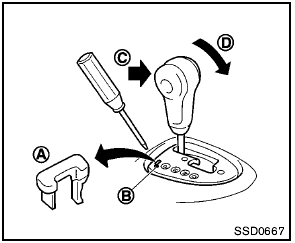Shift lock release

Shift lock release
If the battery charge is low or discharged, the selector lever may not be moved from the P (Park) position even with the brake pedal depressed and the selector lever button pushed.
To move the selector lever, release the shift lock.
The selector lever can be moved to the N (Neutral) position. This allows the vehicle to be moved if the battery is discharged.
To release the shift lock, perform the following
procedure:
1. Turn the ignition switch to the LOCK
position, and remove the key if it is inserted.
2. Apply the parking brake.
3. Remove the shift lock release cover A using a suitable tool.
4. Push down the shift lock release B using a suitable tool.
5. Push the selector lever button C and move the selector lever to the N (Neutral) position D while holding down the shift lock release.
Turn the ignition switch to the ON position. The vehicle may be moved to the desired location.
Replace the removed shift lock release cover after the operation.
If the selector lever cannot be moved out of the P (Park) position, have a NISSAN dealer check the CVT system as soon as possible.

If the selector lever cannot be moved from the P (Park) position while the engine is running and the brake pedal is depressed, the stop lights may not work. Malfunctioning stop lights could cause an accident injuring yourself and others.
See also:
Passenger compartment
1. Interior trunk access (P. 1-8)
2. Moonroof (if so equipped) (P. 2-46)
3. Sun visors (P. 3-28)
4. Interior lights, illuminated entry (P. 2-48)
5. HomeLink universal transceiver
(if so equippe ...
Manual command selection
Commands can be selected manually. While the
commands are displayed on the audio screen,
select a command by operating the audio tuning
switch, and then push the switch.
Once a
command is m ...
Storage bin
Storage bin
Pull the lid down to open the storage bin.
Some models are equipped with a soft lining in
the storage bin for storing sunglasses.
Keep the storage bin closed while driving
to ...
